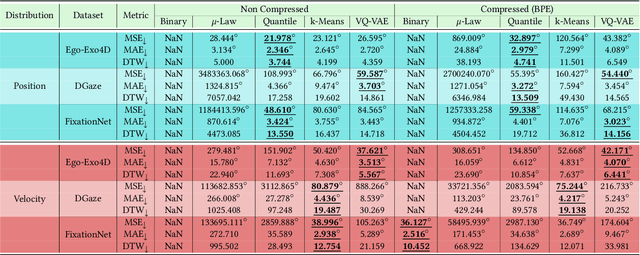Niklas Hypki
Tokenization of Gaze Data
Mar 28, 2025



Abstract:A considerable part of the performance of today's large language models (LLM's) and multimodal large language models (MLLM's) depends on their tokenization strategies. While tokenizers are extensively researched for textual and visual input, there is no research on tokenization strategies for gaze data due to its nature. However, a corresponding tokenization strategy would allow using the vision capabilities of pre-trained MLLM's for gaze data, for example, through fine-tuning. In this paper, we aim to close this research gap by analyzing five different tokenizers for gaze data on three different datasets for the forecasting and generation of gaze data through LLMs (cf.~\cref{fig:teaser}). We evaluate the tokenizers regarding their reconstruction and compression abilities. Further, we train an LLM for each tokenization strategy, measuring its generative and predictive performance. Overall, we found that a quantile tokenizer outperforms all others in predicting the gaze positions and k-means is best when predicting gaze velocities.
A Hands-free Spatial Selection and Interaction Technique using Gaze and Blink Input with Blink Prediction for Extended Reality
Jan 20, 2025



Abstract:Gaze-based interaction techniques have created significant interest in the field of spatial interaction. Many of these methods require additional input modalities, such as hand gestures (e.g., gaze coupled with pinch). Those can be uncomfortable and difficult to perform in public or limited spaces, and pose challenges for users who are unable to execute pinch gestures. To address these aspects, we propose a novel, hands-free Gaze+Blink interaction technique that leverages the user's gaze and intentional eye blinks. This technique enables users to perform selections by executing intentional blinks. It facilitates continuous interactions, such as scrolling or drag-and-drop, through eye blinks coupled with head movements. So far, this concept has not been explored for hands-free spatial interaction techniques. We evaluated the performance and user experience (UX) of our Gaze+Blink method with two user studies and compared it with Gaze+Pinch in a realistic user interface setup featuring common menu interaction tasks. Study 1 demonstrated that while Gaze+Blink achieved comparable selection speeds, it was prone to accidental selections resulting from unintentional blinks. In Study 2 we explored an enhanced technique employing a deep learning algorithms for filtering out unintentional blinks.
A Toolkit for Virtual Reality Data Collection
Dec 23, 2024Abstract:Due to the still relatively low number of users, acquiring large-scale and multidimensional virtual reality datasets remains a significant challenge. Consequently, VR datasets comparable in size to state-of-the-art collections in natural language processing or computer vision are rare or absent. However, the availability of such datasets could unlock groundbreaking advancements in deep-learning, psychological modeling, and data analysis in the context of VR. In this paper, we present a versatile data collection toolkit designed to facilitate the capturing of extensive VR datasets. Our toolkit seamlessly integrates with any device, either directly via OpenXR or through the use of a virtual device. Additionally, we introduce a robust data collection pipeline that emphasizes ethical practices (e.g., ensuring data protection and regulation) and ensures a standardized, reproducible methodology.
 Add to Chrome
Add to Chrome Add to Firefox
Add to Firefox Add to Edge
Add to Edge